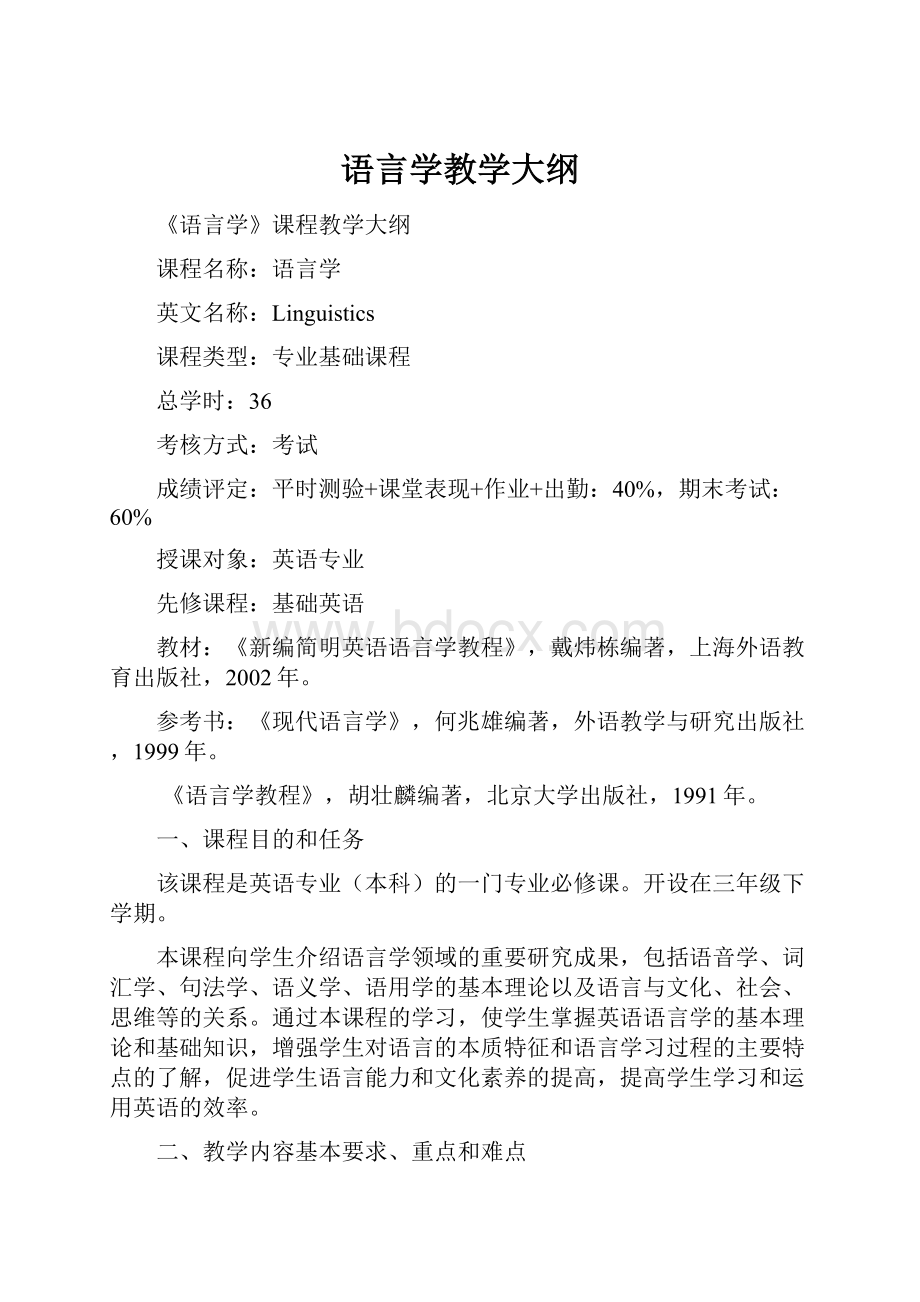 语言学教学大纲.docx
语言学教学大纲.docx
- 文档编号:23471529
- 上传时间:2023-05-17
- 格式:DOCX
- 页数:14
- 大小:20.75KB
语言学教学大纲.docx
《语言学教学大纲.docx》由会员分享,可在线阅读,更多相关《语言学教学大纲.docx(14页珍藏版)》请在冰豆网上搜索。

语言学教学大纲
《语言学》课程教学大纲
课程名称:
语言学
英文名称:
Linguistics
课程类型:
专业基础课程
总学时:
36
考核方式:
考试
成绩评定:
平时测验+课堂表现+作业+出勤:
40%,期末考试:
60%
授课对象:
英语专业
先修课程:
基础英语
教材:
《新编简明英语语言学教程》,戴炜栋编著,上海外语教育出版社,2002年。
参考书:
《现代语言学》,何兆雄编著,外语教学与研究出版社,1999年。
《语言学教程》,胡壮麟编著,北京大学出版社,1991年。
一、课程目的和任务
该课程是英语专业(本科)的一门专业必修课。
开设在三年级下学期。
本课程向学生介绍语言学领域的重要研究成果,包括语音学、词汇学、句法学、语义学、语用学的基本理论以及语言与文化、社会、思维等的关系。
通过本课程的学习,使学生掌握英语语言学的基本理论和基础知识,增强学生对语言的本质特征和语言学习过程的主要特点的了解,促进学生语言能力和文化素养的提高,提高学生学习和运用英语的效率。
二、教学内容基本要求、重点和难点
【基本要求】
1.正确认识课程的性质、任务及其研究对象。
基本把握课程的体系与结构。
了解英语语言的起源、发展及其变化过程,进一步熟悉与理解英语语言的有关现象与概念。
2.对语言与社会、语言与文化和语言与外语教学等方面之间的关系有一定的了解,将所学的语言学基础知识用于指导第二语言的学习,提高语言理论素养,特别是提高英语的正确运用能力和得体的交际能力。
【重点、难点】
1.教学重点:
音位学,语用学,社会语言学,语言学与外语教学
2.教学难点:
句法学,语义学,心理语言学
第一章绪论
【目的要求】
1.掌握语言学的概念、语言的概念及其甄别性特征。
2.熟悉语言学研究中的几对基本概念。
3.了解语言学研究的各个语言层面以及语言学的各个分支。
【重点、难点】
1.教学重点:
语言学的概念、语言的概念及其甄别性特征。
2.教学难点:
语言学研究中的几对基本概念。
【教学方法与教学手段】
讲授式、讨论式
【教学时数】2学时
【思考与练习】
1﹒Howdoyouinterpretthedefinitionoflinguistics:
Linguisticsisthescientificstudyoflanguage?
2﹒Whatarethemajorbranchesoflinguistics?
Whatdoeseachofthemstudy?
3﹒Whatcharacteristicsoflanguageshouldbeincludedinagood,comprehensivedefinitionoflanguage?
4﹒WhatarethemainfeaturesofhumanlanguagethathavebeenspecifiedbyC.Hocketttoshowthatitisessentiallydifferentfromanimalcommunicationsystem?
第二章音系学
【目的要求】
1.通过语音学部分的学习,了解各种发音器官及其作用,英语的元音和辅音的发音方式和特点,分清宽式标音法和窄式标音法的区别。
2.通过音系学部分的学习,理解音系学和语音学的联系和区别,熟悉音系学中的一些基本概念和规则。
【重点、难点】
1.教学重点:
英语语音学的发音特征和音系学中的基本概念。
2.教学难点:
发音器官的构造,音系学中的音素、音位和音位排列规则。
【教学方法与教学手段】
讲授式、讨论式
【教学时数】4学时
【思考与练习】
1﹒Whatisvoicingandhowisitcaused?
2﹒Explainwithexampleshowbroadtranscriptionandnarrowtranscriptiondiffer?
3﹒HowaretheEnglishconsonantsclassified?
4﹒WhatcriteriaareusedtoclassifytheEnglishvowels?
5﹒Howdophoneticsandphonologydifferintheirfocusofstudy?
6﹒Whatisaphone?
Howisitdifferentfromaphoneme?
Howareallophonesrelatedtoaphoneme?
7﹒Explainwithexamplesthesequentialrule,theassimilationrule,andthedeletionrule.
第三章形态学
【目的要求】
1.熟悉语素的概念,包括语素的类型、常见词根和词缀的意义,加强对英语派生词和复合词的理解和运用能力。
2.了解构词的形态规则。
【重点、难点】
1.教学重点:
语素的概念和基本构词法。
2.教学难点:
词的形态变化与意义变化。
【教学方法与教学手段】
讲授式、讨论式
【教学时数】4学时
【思考与练习】
1.Thinkofthreemorphemesuffixes,givetheirmeaning,andspecifythetypesofstemtheymaybesuffixedto.Giveatleasttwoexamplesofeach.
2﹒Thinkofthreemorphemeprefixes,givetheirmeaning,andspecifythetypesofstemtheymaybeprefixedto.Giveatleasttwoexamplesofeach.
第四章句法学
【目的要求】
1.掌握句法的定义和短语的构成因素。
2.学会对短语以及句子进行分析,把握转换规则。
【重点、难点】
1.教学重点:
对短语和句子进行分析。
2.教学难点:
转换生成语法分析。
【教学方法与教学手段】
讲授式、讨论式
【教学时数】4学时
【思考与练习】
1﹒Drawphrasestructuretreesforeachsentence.
a)Thejetlanded.
b)Mariebecameveryill.
c)Whatwillyoutalkabout?
d)Theapplemighthittheman.
e)Heoftenreadsdetectivestories.
2﹒Drawatreestructureforeachofthesentences.
a)Jimhaswashedthedirtyshirtsandpants.
b)Helenputonherclothesandwentout.
c)Maryisfondofliteraturebuttiedofstatistics.
d)Thedetectivewentoutandthemysteriousmancamein.
e)Crusoeknowsthatspringwillcomeandthesnowwillmelt.
3﹒Drawthedeepstructureandsurfacestructuretreesforeachofthesesentences.
a)Theessaythathewrotewastoolong.
b)Thedogthathekeepsbites.
c)Herbertfoundthemansheloved.
d)Thegirlwhomheoftenquarrelswithmajorsinlinguistics.
第五章语义学
【目的要求】
1.掌握语义学的定义和词汇意义。
2.熟悉词汇之间和句子之间的语义关系。
3.了解语义研究的几种主要理论,以及意义分析的两种方法—成分分析法和述谓结构分析法。
【重点、难点】
1.教学重点:
词汇之间的意义关系,成分分析法和述谓结构分析法。
2.教学难点:
句子之间的意义关系。
【教学方法与教学手段】
讲授式、讨论式
【教学时数】4学时
【思考与练习】
1﹒Whatarethemajorviewsconcerningthestudyofmeaning?
2﹒WhatarethemajortypesofsynonymsinEnglish?
3﹒Explainwithexamples“homonymy”,“polysemy”,and“hyponymy”.
4﹒Howcanwordsoppositeinmeaningbeclassified?
Towhichcategorydoeseachofthefollowingpairsofantonymsbelong?
north/south,vacant/occupied,literate/illiterate,above/below,doctor/patient,wide/narrow,poor/rich,father/daughter
5﹒Identifytherelationsbetweenthefollowingpairsofsentences.
a)Tom’swifeispregnant.Tomhasawife.
b)Mysisterwillsoonbedivorced.Mysisterisamarriedwoman.
c)Helikesseafood.Helikescrabs.
d)Theyaregoingtohaveanotherbaby.Theyhaveachild.
第六章语用学
【目的要求】
1.了解语用学和传统的语义学研究之间的关系,以及语境和话语意义的概念。
2.理解言语行为理论和合作原则,学会用言语行为理论分析话语,能在实践中运用合作原则。
【重点、难点】
1.教学重点:
言语行为理论,合作原则。
2.教学难点:
语境,话语意义。
【教学方法与教学手段】
讲授式、讨论式
【教学时数】4学时
【思考与练习】
1﹒Whatdoespragmaticsstudy?
Howdoesitdifferfromtraditionalsemantics?
2﹒Whyisthenotionofcontextessentialinthepragmaticstudyoflinguisticcommunication?
3﹒Howaresentencemeaningandutterancemeaningrelated,andhowdotheydiffer?
4﹒AccordingtoAustin,whatarethethreeactsapersonispossiblyperformingwhilemakingutterance.Giveanexample.
5﹒WhatarethefourmaximsoftheCP?
Trytogiveyourownexamplestoshowhowfloutingthesemaximsgivesrisetoconversationalimplicature?
第七章语言变化
【目的要求】
1.了解语言变化的几个层面,包括语音变化,词素变化,句法变化,以及词汇变化。
2.了解语言变化的趋势,并理解其变化的原因。
3.会运用语言变化的原因分析其变化的趋势,特别是词素变化和句法变化。
【重点、难点】
1.教学重点:
语言变化的几个层面,。
2.教学难点:
语言变化的原因。
【教学方法与教学手段】
讲授式、讨论式
【教学时数】2学时
【思考与练习】
1﹒Lookupthefollowingwordsinadictionarywhichprovidestheetymologiesofwords.Ineachcasespeculateastohowtheparticularwordcametobeborrowedfromaparticularlanguage.
size,skill,royal,ranch,robot,potato,astronaut,emerald,pagoda,khaki,bulldoze,hoodlum
2﹒GiveatleasttwoexamplesshowingtheinfluenceofAmericanEnglishonBritishEnglish.
3﹒Findinanybooks,newspapers,orjournalsnewlycoinedwordsinassociationwithsocialandpoliticalneeds,internetorcomputerlanguage.
4﹒Withexample,givesomeplausibleexplanationsforlinguisticchange.
第八章语言与社会
【目的要求】
1.了解社会语言学的定义与范畴,标准语,皮钦语和克里奥耳语。
2.熟悉语言变体。
3.领会双言和双语现象。
【重点、难点】
1.教学重点:
社会语言学的定义与范畴,语言变体,双言和双语现象。
2.教学难点:
皮钦语和克里奥耳语。
【教学方法与教学手段】
讲授式、讨论式
【教学时数】2学时
【思考与练习】
1﹒Howislanguagerelatedtosociety?
2﹒Explainwithanexamplethattheevaluationoflanguageissocialratherthanlinguistic.
3﹒Whatarethemainsocialdialectsdiscussedinthischapter?
Howdotheyjointlydetermineidiolect?
4﹒WhatisregisterasusedbyHalliday?
Illustrateitwithanexampleofyourown.
5﹒WhatlinguisticfeaturesofBlackEnglishdoyouknow?
DoyouthinkBlackEnglishisanillogicalandinferiorvarietyofEnglish?
Why(not)?
6﹒Whatpeculiarfeaturesdoespidginhave?
7﹒Howdobilingualismanddiglossiadiffer,andwhatdotheyhaveincommon?
第九章语言与文化
【目的要求】
1.了解文化的概念,语言和文化的关系,以及萨皮尔-沃尔夫假说。
2.领会基本的文化差异,认识其在教学中的重要性。
3.了解文化重叠和文化扩散,学会跨文化交际。
【重点、难点】
1.教学重点:
理解语言和文化的关系,文化差异。
2.教学难点:
萨皮尔-沃尔夫假说。
【教学方法与教学手段】
讲授式、讨论式、多媒体课件教学
【教学时数】2学时
【思考与练习】
1﹒Trytosumuptherelationbetweenlanguageandculture.Canyoufindsimilarrelationshipbetweenlocaldialectandregionalculture?
2﹒WhatdoyouthinkofSapir-Whorfhypothesis?
Giveexamplesorprooftosupportyourpointofview.
3﹒CanyoufindsomeloanwordsinChinesefromotherlanguages?
Explainhowtheywereusedintheoriginallanguageandhowtheyareusednow?
4﹒Basedonyourownlearningexperiences,pleaseillustratetowhatextentitisnecessarytolearnitsculturewhenlearningaforeignlanguage.
5﹒Whatdoyouthinkoflinguisticimperialismandculturalimperialism?
Isitnonsenseorsomethingworthconsideration?
第十章语言习得
【目的要求】
1.领会儿童语言习得的理论和儿童语言发展的认知因素。
2.了解语言环境和关键期假说。
3.了解儿童语言习得的发展阶段和非典型发展。
【重点、难点】
1.教学重点:
儿童语言习得的理论,关键期假说。
2.教学难点:
儿童语言习得的发展阶段和非典型发展。
【教学方法与教学手段】
讲授式、讨论式、媒体课件教学
【教学时数】2学时
【思考与练习】
1﹒Explaintheterms:
Languageacquisition,LanguageAcquisitionDevice,CriticalPeriodHypothesis.
2﹒Amongthelanguageacquisitiontheoriesmentionedinthischapter,whichonedoyouthinkismorereasonableandconvincing?
Explainwhy.
第十一章第二语言习得
【目的要求】
1.了解第一语言习得和第二语言习得的联系。
2.了解对比分析和错误分析。
3.领会中继语和母语在第二语言习得中的作用。
4.理解第二语言学习模式和语言输入假设,以及第二语言习得的教育学含义。
【重点、难点】
1.教学重点:
第二语言习得理论,错误分析,对比分析,个人差异,关键期假说。
2.教学难点:
第二语言学习模式和语言输入假设。
【教学方法与教学手段】
讲授式、讨论式
【教学时数】2学时
【思考与练习】
1﹒Towhatextentissecondlanguagelearningsimilartofirstlanguagelearning?
Canyoulistsomeprooffromyourownlearningexperiences?
2﹒DoyouuseChineseinEnglishlearningandhow?
Trytoobserveyourselfandpayattentiontothis,whatconclusionscanyoureachabouttheroleofChineseinyourEnglishlearning?
3﹒Basedonyourownexperience,giveatleastthreeexampleswhicharerelatedtoovergeneralizationandperformanceerrors.
4﹒Identifypersonalityfactorsthatmaycontributetothesuccessoflearningasecond/foreignlanguage.
第十二章语言与大脑
【目的要求】
1.了解神经语言学和心理语言学的概念。
2.领会语言和大脑的关系,理解大脑对语言学习的作用。
3.了解失语症的几种类型。
【重点、难点】
1.教学重点:
大脑对语言学习的作用。
2.教学难点:
神经语言学。
【教学方法与教学手段】
讲授式、讨论式
【教学时数】2学时
【思考与练习】
1﹒Whatdistinguishesthehumanbrainfromanon-humanbrain?
2﹒DescribethemajorsymptomsofBroca’saphasia,Wernicke’saphasia,andacquireddyslexia.
3﹒Whataretherelativeadvantagesanddisadvantagesofthetechniquesusedtoinvestigatethebrainintermsofethics,cost,intrusivenessandtypeofinformationyielded.
三、各教学环节学时分配
序号
章节教学内容
学时
理论
实验
其他
合计
1
Chapter1Introduction
2
2
Chapter2Phonology
4
3
Chapter3Morphology
4
4
Chapter4Syntax
4
5
Chapter5Semantics
4
6
Chapter6Pragmatics
4
7
Chapter7LanguageChange
2
8
Chapter8LanguageandSociety
2
9
Chapter9LanguageandCulture
2
10
Chapter10LanguageAcquisition
2
11
Chapter11SecondLanguageAcquisition
2
12
Chapter12LanguageandBrain
2
13
Revision
2
合计
36
四、说明
在内容教学上,原则以《新编简明英语语言学教程》(戴炜栋编著)为蓝本,但不拘泥于一种教材,教师可根据语言学研究的发展和成果,博采众长,适量取舍和补充。
内容的增减变化一般不超过30%。
对语言学理论中的基本概念不作随意增减。
在教学方法上,以课堂讲授为主,课堂讨论和指导学生课外阅读为辅助。
课堂讲授不低于总学时的80%。
提倡把语言学理论与语言学习与教学实
- 配套讲稿:
如PPT文件的首页显示word图标,表示该PPT已包含配套word讲稿。双击word图标可打开word文档。
- 特殊限制:
部分文档作品中含有的国旗、国徽等图片,仅作为作品整体效果示例展示,禁止商用。设计者仅对作品中独创性部分享有著作权。
- 关 键 词:
- 语言学 教学大纲
 冰豆网所有资源均是用户自行上传分享,仅供网友学习交流,未经上传用户书面授权,请勿作他用。
冰豆网所有资源均是用户自行上传分享,仅供网友学习交流,未经上传用户书面授权,请勿作他用。


 《公务员财产申报制度》.docx
《公务员财产申报制度》.docx
